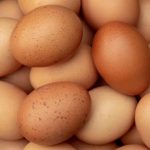 Until the sixteenth century, the yolk-containing ovoid produced by a hen was commonly called an eye, a word in no way related to the eye that refers to the organ of sight. This eye—the one meaning egg—was the direct descendent of the Old English aeg, meaning egg, first recorded more than a thousand years ago. Sometime in the sixteenth century, however, this eye disappeared as it was gradually supplanted by the word egg itself, an Old Norse word introduced to English in the ninth or tenth century by Scandinavian raiders. In all probability, the Old Norse word (egg) managed to displace its native English cousin(eye) because the eye that meant egg was too confusingly similar to the eye that means eye: England was not big enough for the two eyes, so one of them had to go. Unrelated to either of these words is egg the verb, the one meaning to urge as in, “Timmy knew better than to tease the ferret, but his friends egged him on.” This egg derives from another Old Norse word, eggja, meaning edge, the idea being that urging someone to do something makes them “sharp” or “keen” to do it.
Until the sixteenth century, the yolk-containing ovoid produced by a hen was commonly called an eye, a word in no way related to the eye that refers to the organ of sight. This eye—the one meaning egg—was the direct descendent of the Old English aeg, meaning egg, first recorded more than a thousand years ago. Sometime in the sixteenth century, however, this eye disappeared as it was gradually supplanted by the word egg itself, an Old Norse word introduced to English in the ninth or tenth century by Scandinavian raiders. In all probability, the Old Norse word (egg) managed to displace its native English cousin(eye) because the eye that meant egg was too confusingly similar to the eye that means eye: England was not big enough for the two eyes, so one of them had to go. Unrelated to either of these words is egg the verb, the one meaning to urge as in, “Timmy knew better than to tease the ferret, but his friends egged him on.” This egg derives from another Old Norse word, eggja, meaning edge, the idea being that urging someone to do something makes them “sharp” or “keen” to do it.
Immature stage of amanitas and stinkhorns; also a peridiole of bird’s nest fungi.
The female reproductive cell; the medical term is ovum. Produced in the ovary, the egg is the largest cell in the human body, big enough to be seen with the naked eye. All of the eggs a woman will ever produce are present in her body at birth. But the ovaries only release one egg a month during a woman’s reproductive years, a process called ovulation. The egg is released from a structure within the ovary called a follicle and then is swept into the fallopian tube to travel toward the uterus. If fertilized by a sperm cell from a male as a result of sexual intercourse, the cells of the fertilized egg can divide and multiply and develop into an embryo. Because of the unique way that both sperm and egg cells divide (meiosis), a single egg contains only half as much genetic information as any other cell in the body. When a sperm and egg unite, the genetic material from each parent is mixed in the new cell that is formed.
The female sex cell or ovum, applied esp. to a fertilized ovum that is passed from the body and develops outside, as in fowls.
The term “egg” typically refers to the ovum laid by a hen, although eggs laid by other avian creatures can also be utilized.
